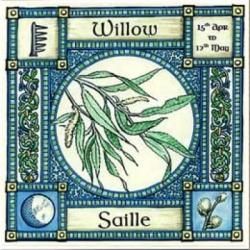Weeping willows were my mother's favorite trees, and so they became mine as well. I made up a song about willows, a lilting chant of their name, and whispered it into the air when I was alone, hoping the wind would bring it to them. I imagined their answers.
When I was first drafting The Dragon's Message (published March 2014), I knew there had to be some sort of boundary that Rhiannon and Gwydion crossed over from her world to the Ruins of DragonsGate. Immediately a wall of willows came to my mind's eye. What better access to a magical realm than to pass through those curtain of branches that always were so enchanting to me? And again, in Love Lies Bleeding, The Wood & Stone Series Part One (published May 2015) it seemed only natural to me for Aislin's favorite tree to be a willow.
In the Ogham alphabet, the writing system of the ancient Celts, the willow, or "Saille," is the symbol for the letter/sound "S." (The Ogham willow is technically not the weeping willow, but the pussy willow, although both trees are very similar in energies.) Willows thrive near water, of which they are considered queen. Like its kingly counterpart, the alder tree (featured in my last blog post), the willow at the water's edge crosses the boundaries between this world and the Otherworld. As such, the willow also represents intuition, imagination, and the ebb and flow of both the moon and tides.
As Stevie Nicks sings, "Like a willow, I can bend..."
The willow is sacred to the goddess Ceridwen, who rules over the moon and is the keeper of the cauldron of inspiration. Her cauldron bestows poetic vision, divine inspiration, and restoration of creative flow. Bards, the poets who are walkers between worlds, made their harps out of willow. Incidentally, a cauldron and a bard both have roles to play in Songs Within Stone (published June 2015) and Branch and Grail, the second and third parts of The Wood & Stone Series. Willow can also bring dreams, both as an access to the Otherworld and as a source for healing and comfort. The chemical salicin found in the willow was used in ancient and medieval times for pain relief.
In Love Lies Bleeding, the willow is a comfort to young Aislin, who plays by the tree to escape her mother's illness and feed her wild nature. It is the willow who delivers the message from the Otherworld to Aislin, starting her on the path to rediscovery and rebirth.
Pass through the wall of the Willow. Sit beneath her and let the ebb and flow of her branches in the wind enfold you in times of sorrow or when you need to get in touch with your intuition or creative spirit. She'll help you get through Writer's Block! The Willow has always given me inspiration and comfort. May she do the same for you!
Enjoy the inspirational music of these modern bards!
Speaking of Stevie Nicks...these ladies also play an incredible rendition of Rhiannon!
~ saille ~
Works Reference and Recommended:
Celtic Tree Magic by Danu Forest
All pictures are from Pinterest. If a work is yours and you would not like it to be used in this post, please contact me and I will remove it. Thank you.





